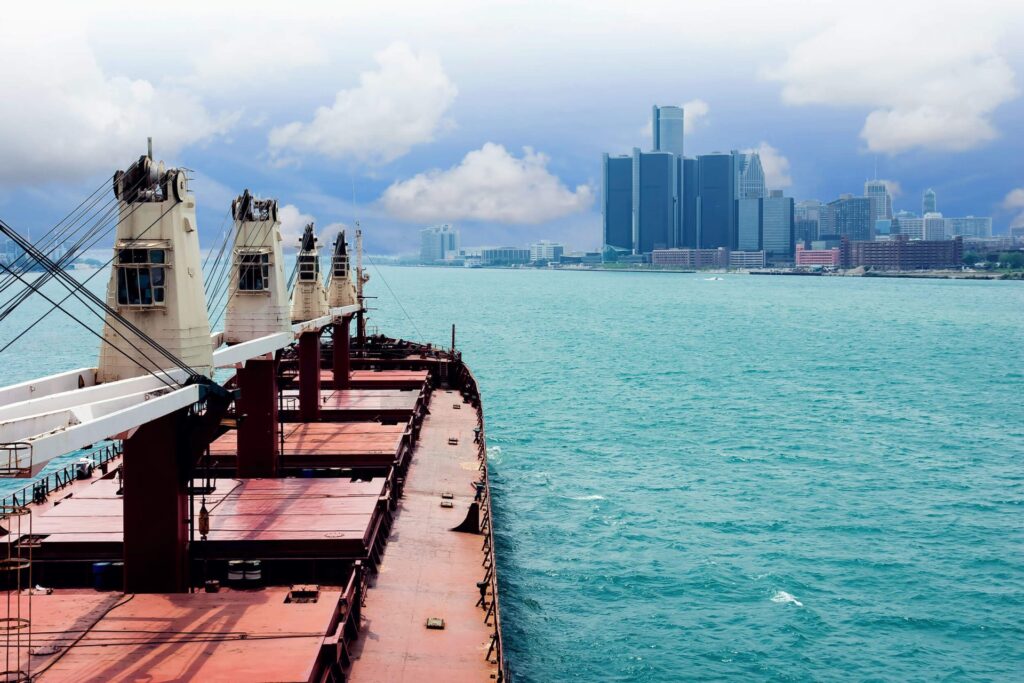Digest on Transport Canada’s 2013 Tanker Safety Expert Panel report covering areas south of the 60th parallel.
Executive Summary
Clear Seas Centre for Responsible Marine Shipping – Research Digest Highlights of A Review of Canada’s Ship-Source Oil Spill Preparedness and Response Regime – Setting The Course for the Future.
Clear Seas is an independent, not-for-profit organization that provides impartial and evidence-based research to inform the public and policy makers about marine shipping in Canada.
Accordingly, we are providing this digest on Transport Canada’s 2013 Tanker Safety Expert Panel report A Review of Canada’s Ship-Source Oil Spill Preparedness and Response Regime – Setting The Course for the Future covering areas south of the 60th parallel. The report is based on substantial and targeted engagement sessions with industry, government, and indigenous organizations during April and June of 2013.
This short digest is not meant to be inclusive of all the Review’s commentary and/or recommendations, nor are the items mentioned necessarily in the same order as the original report.
Message from the Executive Director
Since the mid-1990s Canada has had in place a Ship-source Oil Spill Preparedness and Response Regime that is based on a public-private partnership.
As this Review notes this was the first such comprehensive examination of this regime in almost 20 years. It was necessitated by the fact that the dynamics of oil transportation and marine shipping have changed substantially over the past two decades. Factors that have changed during this time include: greater resource production, increased import and export activity, much busier ports, and the reality that the current Regime is no longer sufficiently up to date on new and alternative response options, or in modern-day effective risk planning.
Although all the recommendations have, directly or indirectly, spill prevention implications, from Clear Seas’ perspective, we were particularly encouraged with those dealing with Area Response Planning, Integrated Planning, Alternative Response Techniques, and Incident Command and Contingency Planning. It is these recommendations that this digest concentrates on.
Background
A lot of oil is transported as cargo in Canadian waters south of the 60th parallel. This map shows the regional breakdown – in million tonnes – as approximate annual averages over the previous 10 years.

With such a volume being shipped it is imperative that we do everything possible to prevent spills from occurring, and that we have robust preparedness and response plans in place to respond to a spill promptly should one occur.
When it comes to cleaning up ship source oil pollution in Canadian waters we operate under the polluter pays principle. In general terms, that means ship and cargo owners share the financial burden of providing clean-up and other restitution compensation.
On the public side of the equation, a number of federal agencies and departments play prominent roles. For example, Transport Canada is the department that carries out the Government’s legislative and regulatory mandate, the Canadian Coast Guard oversees – or where necessary takes charge of – oil spill response, while Environment Canada[1] and Fisheries and Oceans Canada provide scientific, environmental and wildlife expertise.
Canada’s current Ship-source Oil Spill Preparedness and Response Regime (hereafter referred to as the “Regime”) is now out of date. The report noted its recommendations were based on a number of key assumptions and observations for improvement, specifically that: response and preparedness should be based on risks identified and most effectively mitigated at regional levels; potential polluters should be prepared to respond to a worst-case discharge; a critical factor in limited environmental and socio-economic damage is response time; and taxpayers should bear no liability for spills in Canadian waters.
Part of Canada’s Regime requires all prescribed vessels and oil handling facilities to have an arrangement with a spill Response Organization[2] certified by Transport Canada. In most circumstances they are tasked with spill cleanup. In order to be certified, a Response Organization must develop a plan that meets a number of planning standards.
As it is currently formulated, the Regime is based on a rigid, national structure that fails to account for the different risks that exist along our expansive coastline and within the Great Lakes, and St. Lawrence Seaway. A one-size-fits-all approach applies equally to all regions of the country, regardless of the volume of the oil being moved or the region-specific environmental sensitivities that may exist.
This is not optimal, as risks are very likely to vary between distinct regions.
Consequently the report recommends a risk-based Area Response Planning[3] model that will be more flexible and responsive – one that can adapt to changes in vessel traffic and the establishment of new marine terminals as well as account for the unique differences that exist between regions. In this context both national and regional risk assessment and response requirements are necessary.
A National Risk Assessment would provide a pan-Canadian perspective as well as a method of assessing the relative risks between regions. It would also be a valuable tool for measuring the potential risks associated with new projects that could increase ship-source traffic or the volume of oil movements. Given that the Government had already commissioned such an assessment in 2013, the report recommended that Transport Canada put in place a review and update process, the results of which should be made public to increase awareness about the risks associated with oil spills.
It further recommended that Transport Canada designate new Areas of Response – defined geographical areas within which certified Response Organizations operate.
Once established, the department should perform Regional Risk Assessments for each Area of Response, incorporating information on navigational hazards, vessel movements, and key sensitivities. These regional assessments should establish Probable Spill Scenarios[4] that could be expected in each Area along with the sites where the most severe environmental and socio-economic impacts could occur in the event of a spill.
Integrated Planning: Comprehensive planning can be a challenge when you have multiple federal agencies with different responsibilities but similar ends. The result can be activities being performed in silos, which in turn can hinder the cohesiveness of preparedness and response effectiveness.
To deal with such a challenge the report made a number of recommendations concerning an integrated planning process among the responsible federal agencies.
Specifically that:
- The agencies collaboratively develop a standardized process for risk-based Area Response Planning;
- The Canadian Coast Guard (CCG) lead the process for developing Area Response Plans in collaboration with other stakeholders. Such plans would identify the resident capacity[5] required to address most Probable Spill Scenarios. The plans should also include Response Organizations’ arrangements for cascading resources and mutual assistance agreements required to address worst-case discharges.
- Transport Canada require Response Organizations to develop detailed Geographic Response Plans[6] that would include specific time standards and identify the response resources that would be maintained locally. And it should certify Area and Geographic Response Plans, which may include the use of alternative spill response techniques.
Alternative Response Techniques: Mechanical recovery of oil is effective only under relatively calm conditions. Alternative techniques such as spill treating agents and in-situ burning can be appropriate for the right conditions and be more effective at limiting environmental and economic damage. The report recommended that the Canadian Coast Guard be given the final authority to approve the use of spill treating agents and other techniques.
Incident Command and Contingency Planning: In March of 2013 the Government announced the Canadian Coast Guard’s adoption of the Incident Command System (ICS)[7], which is standardized on-scene management that organizes people, equipment, operations and communications activities to better manage emergencies. It can also be useful to increase inter-jurisdictional cooperation and communication.
However, for the benefits of the Incident Command System to be realized, other federal authorities as well as the Response Organizations should also understand and be trained in using the System. To that end the panel’s report made a number of specific recommendations regarding the roles and responsibilities of federal participants, the relevant involvement and training of Response Organizations, and annual exercises developed by the Coast Guard.
Conclusion
The above noted-recommendations, along with the others in the full panel review report would, if implemented:
- Strengthen Canada’s ability to prepare for and respond to ship-source oil spills;
- Further improve our liability and compensation options;
- Enhance Canada’s leadership and stewardship of the Regime;
- Improve communication and engagement with Canadians; and
- Ensure Canada’s Regime continues to improve and that would serve as a model worldwide.
[1] Environment Canada has now be renamed to Environment and Climate Change Canada
[2] There are four in Canada: Western Canada Marine Response Organization, Eastern Canada Response Corporation Ltd. Point Tupper Marine Services, Atlantic Emergency Response Team.
[3] Further information on the current status of Government of Canada’s Area Response Planning Initiative can be found at https://www.tc.gc.ca/eng/marinesafety/oep-ers-arp-4473.html
[4] The likely type and sizes of spills that could happen in a given Area of Response.
[5] Resident capacity refers to the resources that Response Organizations are required to maintain. They include the response governance, communications, infrastructure, equipment, people and the necessary logistical support required to limit the environmental and socio-economic impacts of spills.
[6] Geographic Response Pans are much more local and tactical and site specific that Area Plans
[7] ICS is an incident management methodology used to structure and organize on-scene incident response. It provides a flexible and scalable command, control and coordination structure that is applicable to incidents of any type, scope, and complexity. More information on CCG and ICS can be found at https://www.tc.gc.ca/eng/mediaroom/wcts-incident-command-sys-7555.html



